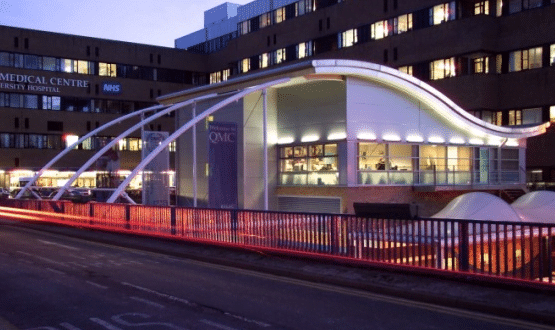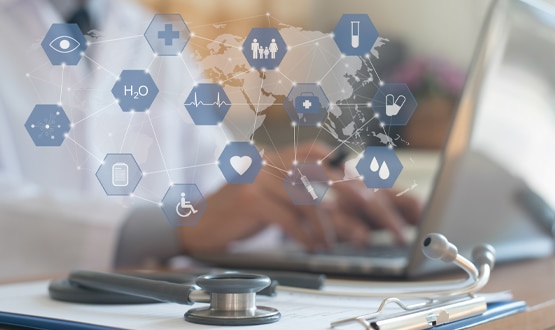Nottingham: Lacing IT all together
- 11 August 2016

Nottingham University Hospitals NHS Trust, which has 14,000 staff and treats a million patients a year, was formed from the merger of Queen's Medical Centre and Nottingham City Hospital ten years ago.
Now the third biggest hospital trust in the country, it’s also one of the most innovative and forward-thinking in its use of IT, operating a best-of-breed policy that entails the management and co-ordination of 354 systems.
The team that welcomes Digital Health News on a site visit includes not just the director of ICT services, Andrew Fearn, but four clinicians who also have IT roles. That is no coincidence, says Fearn: the trust’s model of involving clinicians heavily in IT decision-making is key to its success.
A best of breed approach to EPR
Nottingham was a test site for the Lorenzo electronic patient record, and once planned to work with CSC to create an integrated solution that could be used throughout the hospital.
But when it went to market to replace its McKesson patient administration system (eventually choosing System C), it realised that a best-of-breed approach could offer more choice and control.
The trust began investing heavily in infrastructure, including the deployment of a pervasive wireless network from Cisco, and the implementation of a green IT strategy that involved virtualising 95% of its systems.
(That green strategy arose partly because when QMC opened in 1977, its power requirements were much lower than they are now. “We had to be creative about how we did things,” says Fearn.)
There are no point-to-point interfaces between the different systems. Integration is carried out through a trust integration engine created by a team of specialists employed by the trust, and the systems are connected through IHE standards, such as HL7 and Dicom.
Fearn describes the team as “incredible at moving data around, and they are passionate about healthcare data and getting it right.”
Hospital @ Night
A central feature of Nottingham’s IT strategy has been its partnership with Nervecentre. In 2010, the trust became the first to adopt Nervecentre’s Hospital @ Night, a task management system introduced to support compliance with the European working time directive that replaced the traditional paging system.
The software, which keeps a real-time record of which clinicians are on shift and where they are, enables co-ordinators to assign tasks to the appropriate doctors and nurses, who then accept the tasks on their mobile devices (originally BlackBerry smartphones).
Mark Simmonds, a consultant in acute and critical care, heads up a Recognise and Rescue group that four years ago began looking at how to identify signs of sepsis, acute kidney injury or cardiac arrest and improve the trust’s performance in those areas.
At the time, patient observations and manually-calculated early warning scores were recorded on a paper chart, while handover notes were written on a piece of paper and carried in clinicians’ back pockets.
An audit of paper systems was revealing, he says: “Despite huge amounts of training and education, the recurrent intervention of taking a patient’s observations and then communicating them to someone was actually quite a complex system”.
Adding eObs and eHandover
The work led, two years ago, to the adoption of eObs and eHandover, mobile applications developed by Nervecentre and funded from the ‘Safer Hospitals, Safer Wards: Technology Fund’ or tech fund one.
The new eObs system, which can identify abnormal observations and trigger an alert to the relevant clinician, is saving 150 hours of nursing time a day.
In the new eHandover system, staff select the relevant patient information, such as the diagnosis and the treatment they’re waiting for, from a dropdown menu.
Every member of the team (doctors, nurses, physiotherapists, occupational therapists) can see the information – so if a patient is scheduled to go home the following day, but is waiting for a physiotherapy appointment, the physiotherapist can be informed that the patient needs to be seen urgently. It’s a much smoother, more efficient process.
As part of the implementation, 6,500 frontline staff were given Apple mobile devices (1,500 iPhones, 4,000 iPods and 1,000 iPads).
Sue Clarke, clinical applications specialist, says the devices have provided added benefits: “Nurses and auxiliaries having a device means they can even read their work emails, so communication amongst the team on a ward has improved hugely.
“As a previous ward manager [I found that] trying to get comms out to my team was really difficult. When there were only seven people on duty out of a team of 30, I couldn’t always get them together for a team meeting.”
Making use of all that data
Perhaps the most promising element of the mobile implementations, however, is that they have produced a very rich set of data.
In the past year and a half, says Fearn, eObs has recorded four million sets of observations, while eHandover has recorded three million pieces of data (including information such as who authorised a patient’s discharge and when it happened).
The eObs data on early warning signs has created an opportunity to alert clinicians when a patient is becoming dangerously ill.
Simmonds says: “If you look at sepsis or acute kidney injury or acute cardiac arrest, the common pathway is: your temperature goes up, or your blood pressure drops or your heart rate goes up. It’s those simple observations that are key to identifying the patient who's getting sick.”
The trust has bought Nervecentre software called Clinical Rules, which, says Simmonds, makes it possible to “bring two or three bits of data together to create a rule”.
A system is now being tested that will identify and alert clinicians to the early warning signs of sepsis. Currently about 50% of patients who meet the sepsis criteria will have a diagnosis of infection, and the trust is mindful of the fact that clinicians don’t want to be annoyed by a constantly beeping phone; so the system will include the ability to delay the next alert for six hours.
But Simmonds is hopeful that the final version will be deployed across the whole organisation and will make “a significant difference to the people we're providing care for.”
The data collected by different systems is stored in a vendor neutral archive. The trust has close connections with the University of Nottingham and plans to allow academic colleagues access to the anonymised data for analytics purposes.
Simmonds notes that the ability to combine all the eObs and eHandover data with PAS data, pathology data and, for example, Met Office data, will provide a “huge resource that we’ve got to use”. Analysis of millions of early warning scores, for example, can show how patients fare once allocated a certain score, and lead to an improved calibration of the EWS scale.
Linking with GPs
Although the Nervecentre partnership has led to major efficiency and patient safety improvements, the IT team has been busy in other areas, too.
The hospital operates a simple triage system: when GPs are considering referring patients to the hospital, they first phone the consultant to seek advice on the problem and check which clinic the patient needs to be referred to, or if they need to be referred at all.
This system, which has reduced acute medical admissions by 30%, works hand-in-hand with a Medical Interoperability Gateway that pulls information from different GP systems, so that clinicians can look at the patient’s information before deciding whether they need to come into hospital.
Jeremy Lewis, consultant in general medicine, says: “Because we've already filtered out those patients who could be managed better in primary care or managed best in the department, we can concentrate on serving the needs of those patients that do need to be with us.”
Digital health records are currently being scanned in, so that if a patient has been sent home and then admitted again a few days later, the clinician can look at their record.
“Instead of just seeing the discharge summary on the computer we can see all the notes from the hospital admission, and sometimes that can back up a decision to keep them at home and treat them in the community,” says Lewis.
Remote monitoring
Nottingham is also looking at the role wearable technologies might play in improving patient care. The hospital’s trauma unit has been a pilot site for an Intelesens / GE Healthcare surveillance product, which carries out continual monitoring of temperature and respiration.
Use may be extended to the surgical ward, so the patient can move around while under constant monitoring.
Caron Swinscoe, chief nurse health informatics and head of clinical engagement, says a trial is planned of a wearable patch from Sensium, which also continually monitors temperature and respiration, enabling clinicians to pick up any problems in between four-hourly night-time sets of observations.
Although it’s early days, Swinscoe expects wearables to increase in importance. The trust would like to be able to harness some of patients’ own knowledge about their health, she says, collected through tools such as the Fitbit.
The defining element of the trust’s approach is a focus on the information needs of staff, rather than on the technology used to provide it.
“The trick for us,” says Fearn, “is to ignore systems, ignore the applications and concentrate on the people and the information around those people, so you can shift data out of systems. If you're a doctor on a ward you don't really care which system it is; as long as you can see the information.”




